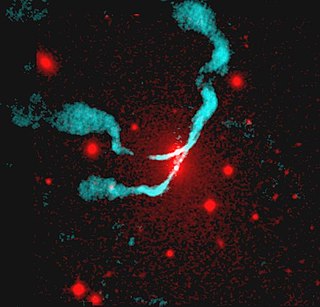
NGC 1128 is a dumbbell galaxy in the Abell 400 galaxy cluster. At the center of the galaxy is 3C 75, a radio source, and contains two orbiting supermassive black holes that may be merging. Computer simulations indicate that these two black holes will gradually spiral in toward each other until they merge. Lewis Swift is credited with the discovery of NGC 1128 in 1886.

NGC 3607 is a small but fairly bright lenticular galaxy in the equatorial constellation of Leo, about 2.5° south of the prominent star Delta Leonis. The galaxy was discovered March 14, 1784 by William Herschel. Dreyer described it as "very bright, large, round, very much brighter middle, 2nd of 3". It is located at a distance of 73 million light years and is receding with a radial velocity of 930 km/s. The galaxy lies southwest of NGC 3626 at an angular separation of ~50′. It occupies the center of the Leo II Group of galaxies, forming one of its two brightest members – the other being NGC 3608. It is a member of the NGC 3607 Group of galaxies, which is a member of the Leo II Groups, a series of galaxies and galaxy clusters strung out from the right edge of the Virgo Supercluster.

NGC 378 is a barred spiral galaxy located in the constellation Sculptor. It was discovered on September 28, 1834 by John Herschel.

NGC 367 is a spiral galaxy in the constellation of Cetus. It was discovered in 1886 by the astronomer Frank Muller.

NGC 368 is a lenticular galaxy in the constellation of Phoenix. It was discovered by John Herschel on September 5, 1834.
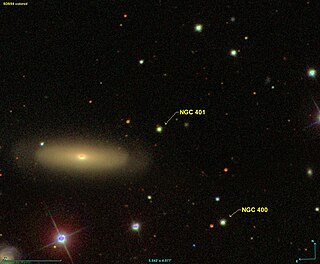
NGC 401 is a star located in the constellation of Pisces. It was discovered on December 30, 1866 by Robert Ball.
NGC 402 is a star located in the constellation of Pisces. It was discovered on October 7, 1874, by Lawrence Parsons.

NGC 410 is an elliptical galaxy located in the constellation Pisces. It was discovered on September 12, 1784 by William Herschel. It was described by Dreyer as "pretty bright, pretty large, northeastern of 2.", the other being NGC 407.

NGC 411 is a globular cluster located approximately 55,000 pc (180,000 ly) from Earth in the constellation Tucana. It was discovered in 1826 by James Dunlop. It was described by Dreyer as "extremely faint, pretty large, round, gradually very little brighter middle". At a distance of about 180,000 light years (55,000 parsecs), it is located within the Small Magellanic Cloud. It has a mass of about 3.0×104 M☉, and a luminosity of about 8.0×104 L☉.
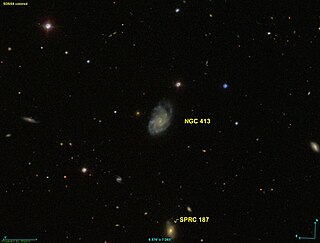
NGC 413 is a spiral galaxy of type SB(r)c located in the constellation Cetus. It was discovered in 1886 by Francis Leavenworth. It was described by Dreyer as "extremely faint, pretty small, very little extended."

NGC 416 is a globular cluster located in the constellation Tucana. It was discovered on September 5, 1826, by James Dunlop. It was described by Dreyer as "faint, pretty small, round, gradually brighter middle". At a distance of about 199,000 ± 9,800 ly (61,000 ± 3,000 pc), it is located within the Small Magellanic Cloud. At an aperture of 31 arcseconds, its apparent V-band magnitude is 11.42, but at this wavelength, it has 0.25 magnitudes of interstellar extinction.

NGC 419 is a globular cluster located approximately 57,000 pc (190,000 ly) from Earth in the constellation Tucana. It was discovered on September 2, 1826 by James Dunlop. It was described by Dreyer as "pretty large, pretty bright, round, gradually brighter middle". At a distance of about 186,000 light years, it is located within the Small Magellanic Cloud. At an aperture of 50 arcseconds, its apparent V-band magnitude is 10.30, but at this wavelength, it has 0.15 magnitudes of interstellar extinction.
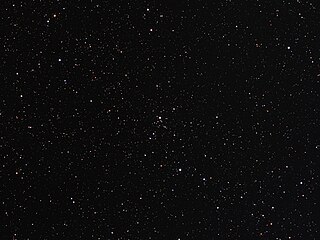
NGC 433 is an open cluster in the northern constellation of Cassiopeia, located at a distance of 6,500 light years from the Sun. It was discovered on September 29, 1829 by John Herschel, and was described by John Dreyer as "cluster, small, a little compressed." The cluster is considered on the poor side, with only 12 stars above magnitude 16. It has a linear diameter of 26.3 ly, with around 479 times the mass of the Sun and an age of 65 million years.
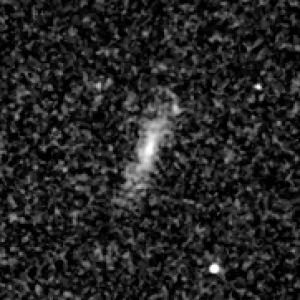
NGC 444 is a spiral galaxy of type Sd located in the constellation Pisces. It was first discovered on October 26, 1854 by R. J. Mitchell, and was also spotted on October 17, 1903 by Stéphane Javelle. It was described by Dreyer as "very faint, much extended 135°, a little brighter middle."

NGC 445 is a peculiar lenticular galaxy located in the constellation of Cetus. It was discovered on October 23, 1864, by Albert Marth. It was described by Dreyer as "very faint, very small."
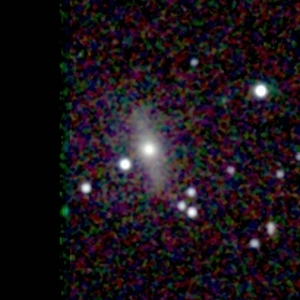
NGC 447 is a spiral galaxy of type (R)SB(rs)0/a located in the constellation Pisces. It was first discovered on October 8, 1861 by Heinrich d'Arrest ; it was also seen in the 1890s by Edward Emerson Barnard. It was described by Dreyer as "faint, pretty large, brighter middle, 11th magnitude star to northeast."

NGC 449 is a spiral galaxy of type (R')S? located in the constellation Pisces. It was discovered on November 11, 1881 by Édouard Stephan. It was described by Dreyer as "very faint, very small, round, very little brighter middle, very faint star involved."

NGC 596 is an elliptical galaxy in the constellation Cetus. The galaxy lies 65 million light years away from Earth, which means, given its apparent dimensions, that NGC 596 is approximately 60,000 light years across. The galaxy shows an outer envelope and is a merger remnant. The surface brightness profil is smooth and featureless. The galaxy hosts a supermassive black hole, whose mass is estimated to be 170 million (108.24) .

NGC 2865 is an isolated elliptical galaxy in the equatorial constellation of Hydra. The core region of the galaxy shows a kinematically distinct component showing indications of a recent accretion or merger event that led to a burst of star formation around the nucleus. Observational constraints require this to have occurred within the last 100–400 million years, with the merger most likely being an Sb or Sc-class spiral galaxy.

NGC 779 is a spiral galaxy seen edge-on, located in the constellation Cetus. It is located at a distance of circa 60 million light years from Earth, which, given its apparent dimensions, means that NGC 779 is about 70,000 light years across. It was discovered by William Herschel on September 10, 1785.



















